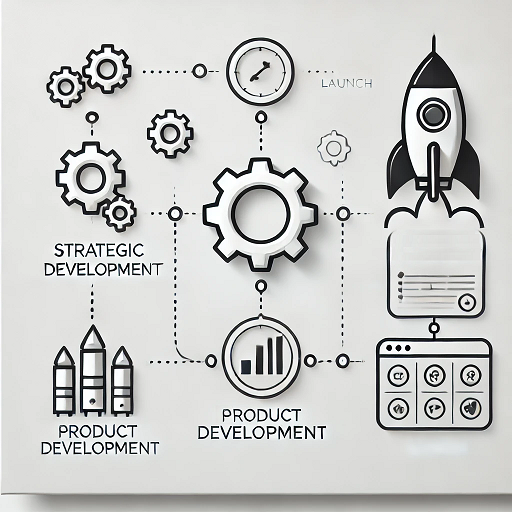Product Roadmaps
Strategic Product Planning: Harnessing Insights for Next-Level Growth
- Jump to section:
- Laying the Groundwork: What Makes an Effective Product Roadmap?
- Building Customer-Centric Roadmaps with Actionable Feedback
- Operationalizing Insights: From Data to Decisive Roadmap Action
- Overcoming Common Pitfalls: Balancing Vision with Market Realities
- Insights in Action: Customer-Driven Roadmaps Powering Growth
- Strategic Product Planning: Best Practices for the Modern Team
- Unifying Insights with ClientCues: Next-Level Market Intelligence

Harness Insights for Growth
Integrating competitor analysis, deep market trend analyses, and customer feedback into your product roadmap enables next-level growth, innovation, and sustained market leadership. This article explains how.
Laying the Groundwork: What Makes an Effective Product Roadmap?
A modern roadmap moves beyond static feature lists—it acts as a strategic blueprint connecting vision, user needs, and market opportunities. Successful teams anchor their roadmap around market research and competitor analysis, using these insights to outpace the market and uncover new growth trends.
Top performers design roadmaps not around arbitrary outputs, but around customer problems and validated market trends. This user-focused, intelligence-driven mindset positions your product for category leadership.
Building Customer-Centric Roadmaps with Actionable Feedback
Integrating deep customer feedback and UI design feedback is crucial for prioritizing initiatives with real user impact. Tie in multiple feedback sources—NPS, social platforms, surveys, and direct interviews—to fuel your roadmap with grounded, market-responsive priorities.
Market intelligence reveals not just what users want, but why—empowering strategic product planning aligned with genuine needs, pain points, and emerging opportunities captured through growth trend recognition and social trend analysis.
Operationalizing Insights: From Data to Decisive Roadmap Action
Transforming insights into well-prioritized roadmaps calls for new techniques: real-time feedback loops, in-app surveys, session recordings, and competitor moves all feed into a living roadmap. This approach ensures your plan consistently adapts to market shifts and changing customer expectations.
Strategic product planning is an ongoing process—use growth trend recognition, competitor comparisons, and live user data to continually refine initiatives and validate every pivot along the way.
- Adopt adaptable roadmaps that respond to both customer and market trends.
- Use feature scoring based on user feedback and competitor analysis for clear prioritization.
- Deploy visual, collaborative tools to communicate roadmap evolution with all teams.
Overcoming Common Pitfalls: Balancing Vision with Market Realities
One major challenge in strategic roadmapping lies in balancing short-term customer demands with long-term innovation. While urgent feature requests appear attractive, sustainable growth demands a broader, strategic view informed by deep market trend analyses and competitor intelligence.
Ensure your feedback systems are robust and represent all personas. Cross-segment analysis and social trend analysis guarantee a holistic, actionable roadmap that accounts for the full spectrum of user voices and market signals.
- Institutionalize systems for continuous, structured feedback analysis.
- Calibrate investments between quick wins and transformative, market-defining features.
- Guarantee all user personas and market niches have representation in roadmap decisions.
Insights in Action: Customer-Driven Roadmaps Powering Growth
Leading SaaS companies and tech innovators now use comprehensive market intelligence—combining customer feedback, competitor tracking, and market research—to recalibrate their roadmaps for growth. The payoff? Not only higher retention and NPS, but faster adoption of new features and accelerated innovation cycles.
From addressing key user pain points to outperforming the competition on rapidly evolving growth trends, these organizations have proven the outsized ROI of data-driven, customer-focused planning.
- Show before/after roadmap KPIs linked to direct customer insights and competitor moves.
- Highlight concrete methods of turning qualitative and quantitative feedback into product success.
- Share real-world strategies for overcoming challenges in roadmap transformation.
Strategic Product Planning: Best Practices for the Modern Team
Modern product teams win by continually integrating market research, user feedback UI design, and internal strategy. Adopt an agile, feedback-driven culture—using regular roadmap reviews, intelligent prioritization, and transparent communications to stay ahead of market shifts.
Consistently seek input from across teams and user segments, establishing clear benchmarks for success that focus on real customer and business outcomes—not just the volume of features shipped.
- Build flexibility into your roadmap so you can pivot as market trends evolve.
- Create continuous feedback loops with both customers and internal stakeholders.
- Align roadmap KPIs with customer satisfaction, engagement, and competitive benchmarks.
Unifying Insights with ClientCues: Next-Level Market Intelligence
Advanced market intelligence platforms like ClientCues bring data-driven clarity to every roadmap iteration. By fusing session records, competitor comparisons, customer feedback, and market signals, you unlock a holistic view of opportunities and friction.
With ClientCues, teams rapidly surface actionable insights for strategic product planning—plugging them right into your roadmap and collaborative workflows for faster, smarter execution in dynamic markets.
- Leverage live competitor and user analytics for roadmap validation.
- Surface hidden opportunities and root causes of friction with AI-powered feedback analysis.
- Automate sharing and reporting of roadmap insights across the entire organization.
Instantly compare features and user sentiment across your market. Get a competitor snapshot with real feedback and web proof—free.